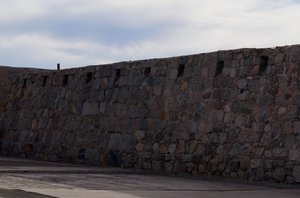Advertisement
Published: February 19th 2015

 FORCED AIR VENTS
FORCED AIR VENTS
The photo shows the east wall of incorrigible cell block from outside the prison. Those cells were frightfully stifling before fresh air was pumped in those ports at the top of the wall. I have no idea how the dynamo got power to run. The first inmates were incarcerated here on July 1, 1876 in cells they built themselves. It was less than a week after Custer’s Last Stand and three days before the national centennial. In Yuma it was hotter than the hinges of hell and the annual monsoon season was just getting underway. Just because it is 120 degrees out does not mean it cannot be humid too. Those inmates did not care a fig about Custer, and did not join in the centennial festivities, but they were glad to have a place to rest their weary bones that was dry and out of the fierce glare of the relentless sun. The cells held the day’s heat like an oven. As the prison grew it eventually got electrification and ventilation ports were added that allowed fresh air to be pumped into the cell block for the incorrigible prisoners. Direct current came to the prison in 1884 generated by means of a dynamo. The prison operated for 33 years when railroad encroachment and overcrowding forced its closure. The last convict walked jauntily through the sally port on September 15, 1909. He was happy enough to leave Yuma but

 PRISON CEMETERY
PRISON CEMETERY
Bloody hell. It was hard work digging those graves in the hot sun. All of them were shallow. None were marked.when he got to the new prison in Florence his saucy smile disappeared. Florence was a much tougher house. In all 3069 convicts pulled a stretch at Yuma, of them 29 were women. One child was born in captivity. Twenty-four escaped from work details and two others broke out. Tuberculosis was a common cause of death at the prison. When a convict died he was buried in a shallow unmarked grave in the prison cemetery and promptly forgotten by all except for those convicts who had to dig the hole by hand in bedrock. In spite of its fearful reputation Yuma was actually a fairly soft prison. The food was good, they provided decent medical and spiritual care, they had a small library, and some convicts even learned to read and write. There were no executions and few violent deaths. Early parole was common. After the prison closed the facility did not stand vacant for long. Yuma High School occupied the premises between 1910 and 1914 when a new school was built. The Yuma High mascot is still “The Criminals” and those kids are proud of it. After the school kids left the hoboes moved in. During the Great Depression

 YUMA PRISON
YUMA PRISON
The general population was housed in this cell block. It was open on both sides so it did not get ventilation from the electric pumps. This is the west side of the cell block looking south. The dark cell and the library were dug into the south wall seen in back. The south wall provided access to the women's cell block. many Okies seeking farm work in California camped on the prison grounds after being turned back on the Ocean to Ocean Bridge by surly cops. It is now a state park and has a dandy museum.
Advertisement
Tot: 0.278s; Tpl: 0.009s; cc: 11; qc: 51; dbt: 0.1366s; 1; m:domysql w:travelblog (10.17.0.13); sld: 1;
; mem: 1.1mb

 FORCED AIR VENTS
FORCED AIR VENTS
 PRISON CEMETERY
PRISON CEMETERY
 YUMA PRISON
YUMA PRISON